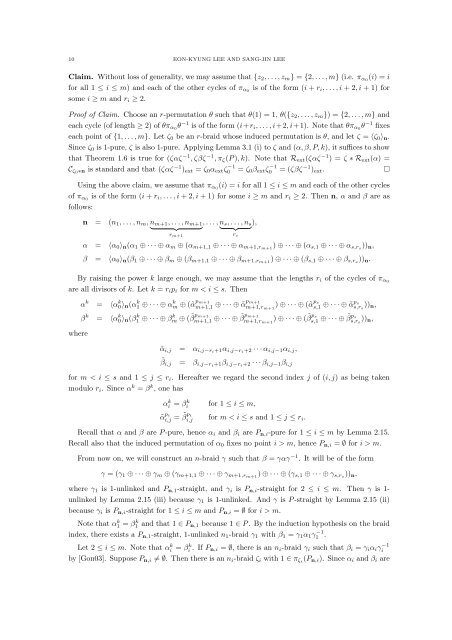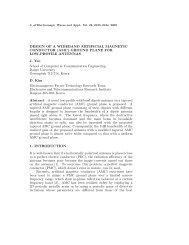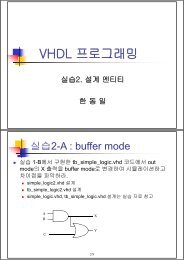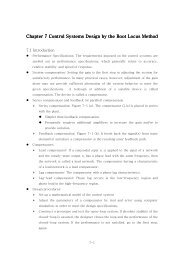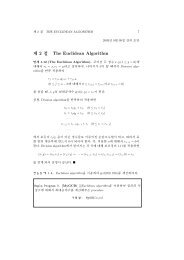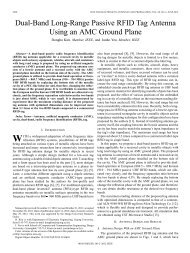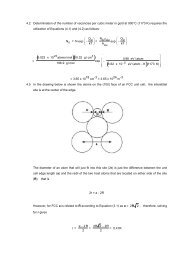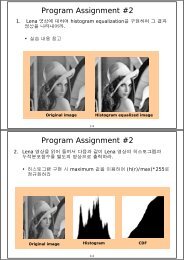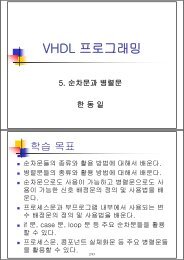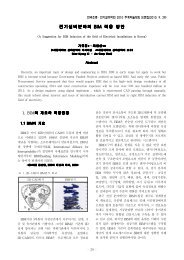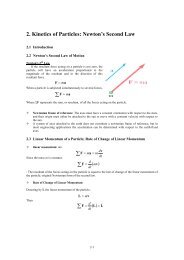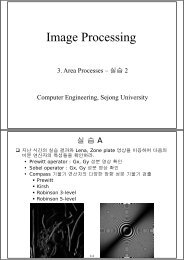UNIQUENESS OF ROOTS UP TO CONJUGACY FOR SOME ...
UNIQUENESS OF ROOTS UP TO CONJUGACY FOR SOME ...
UNIQUENESS OF ROOTS UP TO CONJUGACY FOR SOME ...
You also want an ePaper? Increase the reach of your titles
YUMPU automatically turns print PDFs into web optimized ePapers that Google loves.
10 EON-KYUNG LEE AND SANG-JIN LEE<br />
Claim. Without loss of generality, we may assume that {z 2 , . . . , z m } = {2, . . . , m} (i.e. π α0 (i) = i<br />
for all 1 ≤ i ≤ m) and each of the other cycles of π α0 is of the form (i + r i , . . . , i + 2, i + 1) for<br />
some i ≥ m and r i ≥ 2.<br />
Proof of Claim. Choose an r-permutation θ such that θ(1) = 1, θ({z 2 , . . . , z m }) = {2, . . . , m} and<br />
each cycle (of length ≥ 2) of θπ α0 θ −1 is of the form (i+r i , . . . , i+2, i+1). Note that θπ α0 θ −1 fixes<br />
each point of {1, . . . , m}. Let ζ 0 be an r-braid whose induced permutation is θ, and let ζ = 〈ζ 0 〉 n .<br />
Since ζ 0 is 1-pure, ζ is also 1-pure. Applying Lemma 3.1 (i) to ζ and (α, β, P, k), it suffices to show<br />
that Theorem 1.6 is true for (ζαζ −1 , ζβζ −1 , π ζ (P ), k). Note that R ext (ζαζ −1 ) = ζ ∗ R ext (α) =<br />
C ζ0∗n is standard and that (ζαζ −1 ) ext = ζ 0 α ext ζ0 −1 = ζ 0 β ext ζ0 −1 = (ζβζ −1 ) ext . □<br />
Using the above claim, we assume that π α0 (i) = i for all 1 ≤ i ≤ m and each of the other cycles<br />
of π α0 is of the form (i + r i , . . . , i + 2, i + 1) for some i ≥ m and r i ≥ 2. Then n, α and β are as<br />
follows:<br />
n = (n 1 , . . . , n m , n m+1 , . . . , n m+1 , . . . , n s , . . . , n s ),<br />
} {{ } } {{ }<br />
r m+1<br />
r s<br />
α = 〈α 0 〉 n (α 1 ⊕ · · · ⊕ α m ⊕ (α m+1,1 ⊕ · · · ⊕ α m+1,rm+1 ) ⊕ · · · ⊕ (α s,1 ⊕ · · · ⊕ α s,rs )) n ,<br />
β = 〈α 0 〉 n (β 1 ⊕ · · · ⊕ β m ⊕ (β m+1,1 ⊕ · · · ⊕ β m+1,rm+1 ) ⊕ · · · ⊕ (β s,1 ⊕ · · · ⊕ β s,rs )) n .<br />
By raising the power k large enough, we may assume that the lengths r i of the cycles of π α0<br />
are all divisors of k. Let k = r i p i for m < i ≤ s. Then<br />
where<br />
α k = 〈α0〉 k n (α1 k ⊕ · · · ⊕ αm k ⊕ (˜α p m+1<br />
m+1,1 ⊕ · · · ⊕ ˜αp m+1<br />
m+1,r m+1<br />
) ⊕ · · · ⊕ (˜α p s<br />
s,1 ⊕ · · · ⊕ ˜αps s,r s<br />
)) n ,<br />
β k = 〈α0〉 k n (β1 k ⊕ · · · ⊕ βm k ⊕ ( ˜β p m+1<br />
m+1,1 ⊕ · · · ⊕ ˜β p m+1<br />
ps<br />
m+1,r m+1<br />
) ⊕ · · · ⊕ ( ˜β s,1 ⊕ · · · ⊕ ˜β p s<br />
s,r s<br />
)) n ,<br />
˜α i,j = α i,j−ri +1α i,j−ri +2 · · · α i,j−1 α i,j ,<br />
˜β i,j = β i,j−ri+1β i,j−ri+2 · · · β i,j−1 β i,j<br />
for m < i ≤ s and 1 ≤ j ≤ r i . Hereafter we regard the second index j of (i, j) as being taken<br />
modulo r i . Since α k = β k , one has<br />
α k i = βk i for 1 ≤ i ≤ m,<br />
˜α p i<br />
i,j = ˜β p i<br />
i,j for m < i ≤ s and 1 ≤ j ≤ r i .<br />
Recall that α and β are P -pure, hence α i and β i are P n,i -pure for 1 ≤ i ≤ m by Lemma 2.15.<br />
Recall also that the induced permutation of α 0 fixes no point i > m, hence P n,i = ∅ for i > m.<br />
From now on, we will construct an n-braid γ such that β = γαγ −1 . It will be of the form<br />
γ = (γ 1 ⊕ · · · ⊕ γ m ⊕ (γ m+1,1 ⊕ · · · ⊕ γ m+1,rm+1 ) ⊕ · · · ⊕ (γ s,1 ⊕ · · · ⊕ γ s,rs )) n ,<br />
where γ 1 is 1-unlinked and P n,1 -straight, and γ i is P n,i -straight for 2 ≤ i ≤ m. Then γ is 1-<br />
unlinked by Lemma 2.15 (iii) because γ 1 is 1-unlinked. And γ is P -straight by Lemma 2.15 (ii)<br />
because γ i is P n,i -straight for 1 ≤ i ≤ m and P n,i = ∅ for i > m.<br />
Note that α k 1 = β k 1 and that 1 ∈ P n,1 because 1 ∈ P . By the induction hypothesis on the braid<br />
index, there exists a P n,1 -straight, 1-unlinked n 1 -braid γ 1 with β 1 = γ 1 α 1 γ −1<br />
1 .<br />
Let 2 ≤ i ≤ m. Note that α k i = βk i . If P n,i = ∅, there is an n i -braid γ i such that β i = γ i α i γ −1<br />
i<br />
by [Gon03]. Suppose P n,i ≠ ∅. Then there is an n i -braid ζ i with 1 ∈ π ζi (P n,i ). Since α i and β i are


